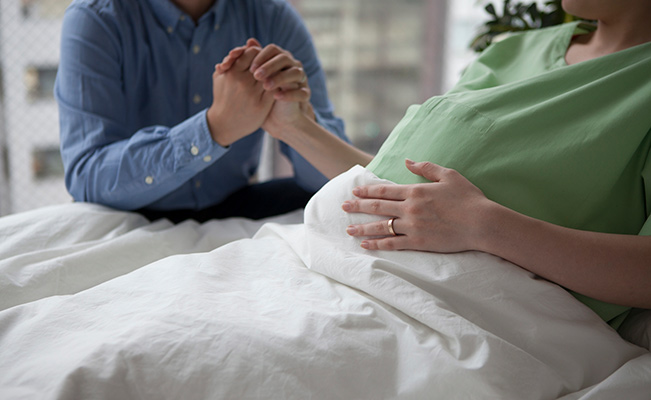
Pregnancy and childbirth are wondrous processes. Ideally, labor and delivery should be short and free of complications, but it’s always a good idea to prepare yourself for those potential complications. While cesarean section delivery has its own risks, for some women, it may be the safer—or only—choice.
Why are cesarean sections necessary?
Many cesarean sections (c-sections) are emergency procedures, but certain factors may make vaginal delivery risky for the mother and/or the baby, and your doctor may recommend a planned c-section.
Emergency cesarean section
- Lack of progress in labor – One of the most common reasons for cesarean section delivery1. Sometimes the cervix does not open enough despite strong contractions, and sometimes the baby’s head and/or body are too large for the birth canal.
- Umbilical cord problems – Sometimes, the umbilical cord may enter the birth canal before the baby does (a situation called umbilical cord prolapse). It can also become pinched, affecting the baby’s oxygen supply2.
- Placental abruption – If the placenta detaches from the walls of your uterus before your due date, you may need an emergency c-section.
- Compromised condition of the baby or mother - In cases where there is very little amount of amniotic fluid inside the womb, and the mother’s condition is worsening (eg: uncontrolled hypertension), an emergency cesarean section may be done. Planned cesarean section
- The baby is in an abnormal position – If your baby is in breech (feet-first) or transverse (sideways), a c-section may be recommended. However, in some cases, doctors may attempt to turn the baby head-down in a process called external cephalic version (ECV). This is done to improve chances of having a vaginal delivery3.
- Some multiple pregnancies – If you are carrying twins and one of them is in an abnormal position, or if you are carrying three or more babies, you may need a c-section.
- Placenta previa – Not to be confused with placental abruption, placenta previa is when the placenta sits too low in the uterus, covering part or all of the cervix.
- Maternal health issues – Some medical conditions—e.g., heart problems, diabetes, high blood pressure, HIV, or genital herpes—may make vaginal delivery risky for the mother and/or the child4.
If your doctor suggests a planned c-section, feel free to discuss this decision in full detail with them. In fact, it won’t hurt to get a second opinion. Even though they are generally safe, c-sections are still major surgeries. Therefore, these are not choices to be made lightly. Potential risks that come with c-sections include increased bleeding, infection, adverse reactions to medicines, blood clots, and possible injuries to the baby.
How it’s done
Upon determining that a c-section is needed, you will be given anesthesia—typically either an epidural or a spinal block. The epidural will dull the pain, but you may feel tugging or pushing. The spinal block takes effect immediately, numbing you from the chest down5.
The doctor will make two incisions. First, usually horizontally (sometimes called a “bikini cut”). This is done through the skin, fat, muscle, and peritoneum. The second incision is through the uterus itself. Usually, the uterine incision is made in the lower segment in a horizontal manner unless there is an indication to do “classical cesarean section,” then the uterine incision may be made vertically in the midline.
The baby is gently pulled out. And the umbilical cord is cut. Then, the placenta is removed. The doctor then closes the uterus with dissolvable stitches. The abdomen, including the skin, is closed with absorbable stitches. The skin, in rare circumstances, may also be closed with staples which can be removed later.
Post-procedure and recovery
After the procedure, you will probably need to spend another 2-4 days in the hospital to rest and recover. Passage of gas or flatus will be asked of you to ascertain if your bowels are already active. You are very much encouraged to start moving about at your own pace (i.e. sitting on the bed, standing up, or ambulating). When you do get up, a nurse or other adult may assist you. When you go home, avoid strenuous activities. Don’t lift anything heavier than your baby.
You may experience bleeding for the first few weeks after a c-section, and pain in or near the incision. Your doctor may prescribe pain medication. Most pain medications are safe for breast-feeding mothers. For the first six weeks or so after a c-section, avoid having sex. Do not place anything in your vagina to prevent infection.
Vaginal births after cesarean delivery (VBAC)
Some women who have had a c-section may seek vaginal delivery for subsequent births. After all, not only will a vaginal birth shorten your recovery time, you will also avoid the risks associated with c-sections. In the past, women who’d already had a c-section were advised to have the same procedure for subsequent births, but today, VBACs are a viable alternative. The success rate for women who attempt a VBAC is around 60-80%6.
Whether or not you can have a VBAC will depend on the reason for your first cesarean, your medical history, and the type of incision to your uterus. A transverse incision makes a VBAC more viable, but a vertical incision may result in rupture should you attempt vaginal delivery. Discuss things fully with your doctor to see if a VBAC is right for you.
Be part of Club Mama today to unlock a world of privileges and benefits which include free samples, exclusive vouchers, promotions, expert advice and many more!
References:
1 “C-section,” Mayo Clinic. Accessed September 13, 2020. https://www.mayoclinic.org/tests-procedures/c-section/about/pac-2039365…;
2 Hirsch, Larissa. “Cesarean Sections (C-Sections),” Nemours KidsHealth. Last modified February 2017. https://kidshealth.org/en/parents/c-sections.html
3 “If Your Baby is in Breech,” The American College of Obstetricians and Gynecologists. Accessed September 13, 2020. https://www.acog.org/patient-resources/faqs/pregnancy/if-your-baby-is-b…;
4 “Cesarean Birth,” The American College of Obstetricians and Gynecologists. Accessed September 13, 2020. https://www.acog.org/patient-resources/faqs/labor-delivery-and-postpart…;
5 “Labor and birth,” Office on Women’s Health. Last modified June 6, 2018. https://www.womenshealth.gov/pregnancy/childbirth-and-beyond/labor-and-…;
6 Ben-Joseph, Elana Pearl. “Can I Have a Vaginal Birth If I had a Previous C-Section?,” Nemours KidsHealth. Last modified May 2015. https://kidshealth.org/en/parents/vbac.html
